Yttrium Al-Diode Laser with Neodymium Doping
(Oh, and I suffered 2 years ago with this material, I decided to lay out, close the gestalt.)
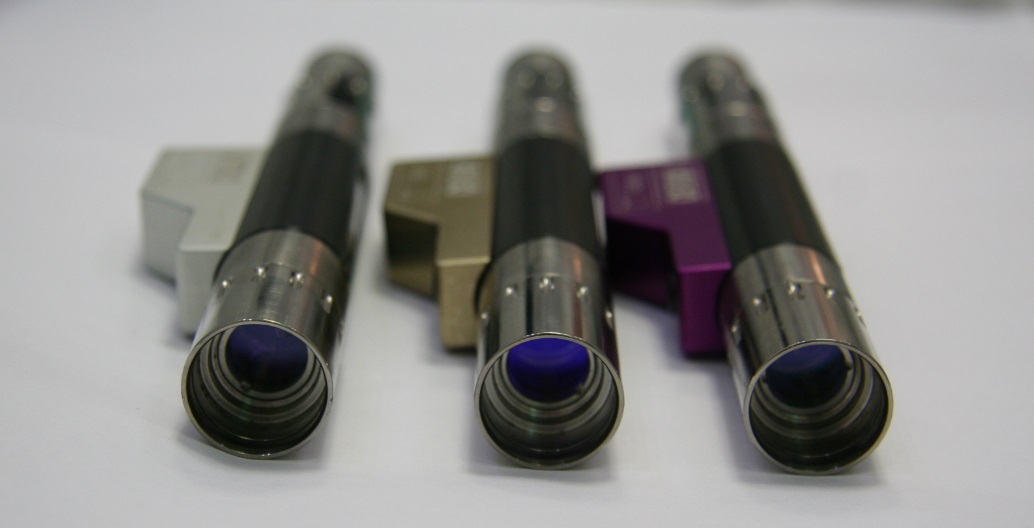
Jedi swords?
Personally, I am a supporter of natural ways to become more beautiful (sports, dancing, yoga, positive, normal nutrition, etc.), but at the same time I understand that there are cases when quick and effective intervention is necessary, so I decided to tell about the laser device which helps to make "all the rouge and nicer", like in a fairy tale. Or rather, about the principle of its work - I hope that after this publication the process of interaction between the laser and living tissue will become more understandable.
The introductory part presents some materials from the field of anatomy, without which it is not easy to understand the purpose of the laser. Also in the introductory question of protecting the eyes from laser radiation. In the second part, there is a description and principle of operation of the 3 systems that are present in the Synchro Play DEKA apparatus.
')

Some theory
The principle of operation Synchro Play DEKA
There are 5 types of skin that doctors share according to their optical characteristics. Depending on the skin type, the depth of penetration and the type of laser are selected.
Human hair growth depends on many factors, such as age, sex, body weight, metabolism, hormones, ethnicity, medication and other factors. Whatever it was, hair growth takes place in three stages:
A lot of time has passed since the idea to direct a laser to a person for medical purposes (1960s), and this direction has yielded significant results and has been approved in the circles of doctors and cosmetologists. Commercial use of lasers in cosmetology dates back to the mid-90s, and this was preceded by 20 years of experimental research in this direction. The first article was published by a group of authors from Massachusetts General Hospital (conducting the world's largest research programs in the field of medicine) in 1998.
In cosmetology, the following types of lasers are most often used:
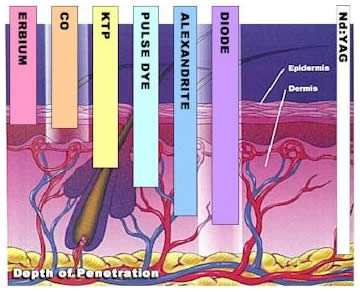
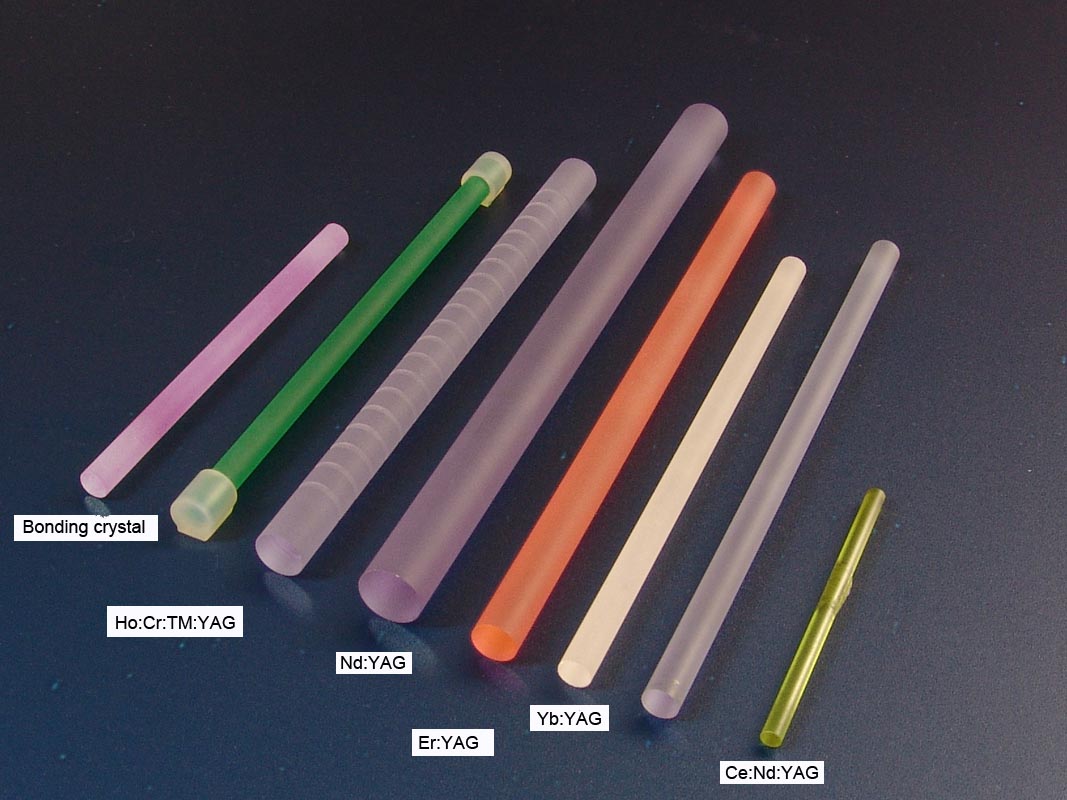
A laser pointer (whose power is 1-20mW) is fun to play with a cat , but it is not recommended to shine in the eyes. Some hooligans blind pilots more powerful (500 mW) pointers. 1-10 W lasers burn a balloon or cap from a marker. What will be from a laser with a power of 125 or 150 watts?

Worldwide, the danger (or safety?) Of lasers is divided into several classes:
 Class 1. Lasers and laser systems of very low power, which are not capable of creating a radiation level dangerous for the human eye. Class 1 systems do not pose any danger even with long-term direct eye observation. In many countries, laser-powered devices with a higher power laser, which have reliable protection against the beam exiting the body, also belong to class 1.
Class 1. Lasers and laser systems of very low power, which are not capable of creating a radiation level dangerous for the human eye. Class 1 systems do not pose any danger even with long-term direct eye observation. In many countries, laser-powered devices with a higher power laser, which have reliable protection against the beam exiting the body, also belong to class 1.
Class 2. Low-power visible lasers that can cause damage to the human eye if you specifically look directly at the laser for a long period of time. Such lasers should not be used at head level. Lasers with invisible radiation cannot be classified as Class 2 lasers. Usually, class 2 includes visible lasers up to 1 milliwatt.
Class 2a . Lasers and laser systems of class 2a, located and fixed in such a way that the beam into the human eye with proper operation is excluded. This class is used only in some countries.
Class 3a. Lasers and laser systems with visible radiation, which are usually not dangerous if you look at the laser with the naked eye only for a short period (usually due to the blink reflex of the eye). Lasers can be dangerous if viewed through optical instruments (binoculars, telescopes). Usually limited to a power of 5 milliwatts. In many countries, devices of higher classes in some cases require a special permit for operation, certification or licensing. International classes 2 and 3a roughly correspond to Russian class 2.
Class 3b. Lasers and laser systems that are dangerous when viewed directly on the laser. The same applies to the specular reflection of the laser beam. A laser belongs to class 3b if its power is more than 5 milliwatts. In Russia, roughly correspond to class 3.
Class 4. High-power lasers and laser systems that can cause severe damage to the human eye with short pulses (<0.25 s) of a direct laser beam, as well as specular or diffusely reflected light. Lasers and laser systems of this class can cause significant damage to human skin, as well as have a dangerous effect on highly flammable and combustible materials.
The device Synchro Play DEKA, about which today will be discussed, 4 class security, therefore, you need to be very careful.
The peculiarity of laser radiation is that it can get into the eye with closed eyelids, even because of the angle, and you may not notice it at all. Light to light is different, and below is the behavior of different wavelengths when it enters the eye.
Penetration of light with different wavelengths into the eye:
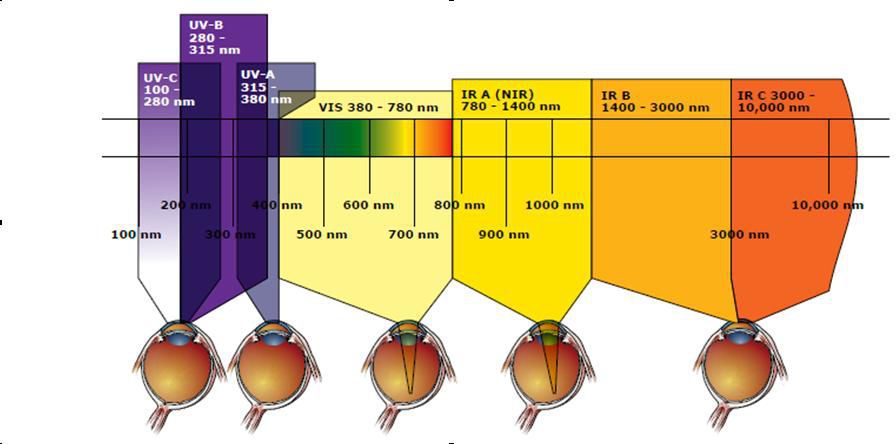
1. Ultraviolet light with a wavelength of less than 350 nm falling on the eye is absorbed by the cornea of the eye. The consequence of exposure to high power of light at these wavelengths is damage, leading to the destruction of the cornea or the formation of a cataract.
2. The light perceived by the retina is in the visible wavelength range (380 - 780 nm). Since human eye is sensitive to light, people have developed natural defense mechanisms. When the light seems too bright, i.e. power density exceeds the damage threshold of the eye, we automatically turn away and close our eyes (i.e. response or blinking reflex). This automatic response is effective for radiation power up to 1 mW. At higher powers, too much energy will be absorbed by the retina before we blink; this can lead to irreversible damage.
3. The near-infrared range (780 - 1400 nm) is the most dangerous for the human eye, because we do not have natural protection against it. The eye will feel radiation falling on the retina only after irreparable damage has already been done.
4. Infrared radiation in the range of 1400 - 11000 nm is absorbed by the surface of the eye and does not reach the retina. This leads to overheating of the tissue and burning, or destruction of the cornea. However, this occurs only at much higher power than those that are dangerous to the retina.
To the cosmetic procedure does not end at the oculist, use sunglasses 80 th level:

Laser flashes are so powerful that they even penetrate through the lowered eyelids. Therefore, special blind metal glasses are worn to the interest.
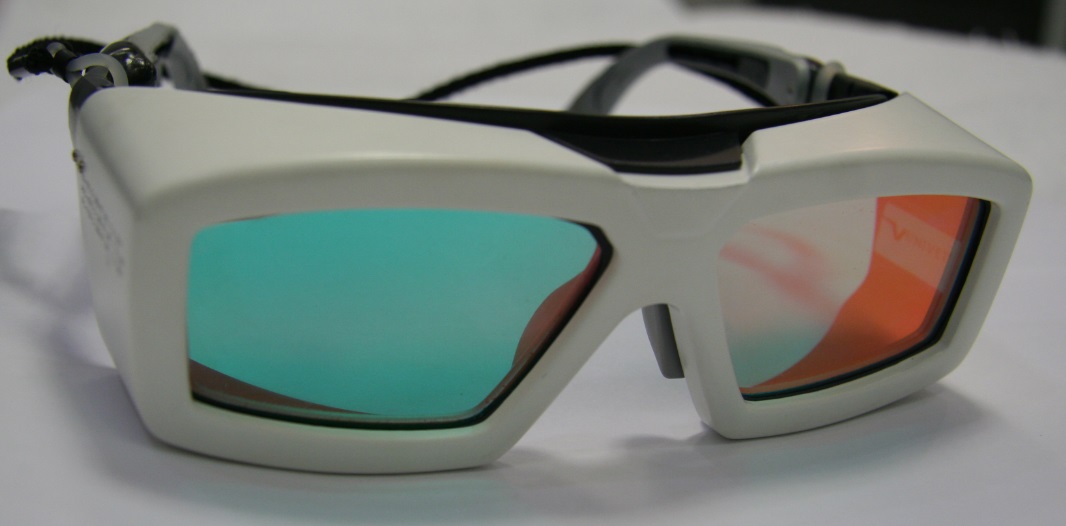
Points for the operator. For each type of lasers, glasses are selected with a specific light filter that transmits the maximum amount of visible light, but blocks light at the laser wavelength. Convenience of work in laser goggles depends on the parameter VLT (visible light transmission, visible light transmission).
The attenuation of light by a filter in the visible spectrum is determined by said VLT. It is determined by the ratio to the standard light source and is evaluated according to the spectral sensitivity of the eye to daylight. If the measured VLT value is less than 20%, then the user must ensure that there is additional lighting at the workplace. With low VLT and poor lighting, we can expect our eyes to adjust to what is called night vision. At the same time, color vision will be limited and the range of sensitivity of the eyes will shift towards shorter wavelengths.
 Laser hair removal is based on the principle of "selective photothermolysis" - selective absorption of light by various biological structures: hair pigment - melanin , which is concentrated in the stem and hair follicle, is able to absorb light waves of a certain length (optimal range 700-800 nm). As a result of the action of laser radiation, melanin, absorbing the energy of light, heats up and destroys the neighboring cells of the matrix (germ zone of the hair) and the vessels that feed the hair follicle. After a few weeks, the hair shaft with the dead “root” falls out.
Laser hair removal is based on the principle of "selective photothermolysis" - selective absorption of light by various biological structures: hair pigment - melanin , which is concentrated in the stem and hair follicle, is able to absorb light waves of a certain length (optimal range 700-800 nm). As a result of the action of laser radiation, melanin, absorbing the energy of light, heats up and destroys the neighboring cells of the matrix (germ zone of the hair) and the vessels that feed the hair follicle. After a few weeks, the hair shaft with the dead “root” falls out.
Part of the hair follicles is in a sleeping state (about 10-15%) and 80-90% is in active growth. For maximum hair removal (90-100%), a series of hair removal procedures are needed with an interval of 20-45 days, depending on the individual hair growth rate. The number of procedures depends on the type and power of the laser system.
Skin type affects the absorption of waves of a certain length, so there are graphs and correspondence tables for skin phototype and laser / IPL type.

 My acquaintance with medical lasers began with this device. The product is Italian, combines three sources:
My acquaintance with medical lasers began with this device. The product is Italian, combines three sources:
Alexandrite laser - 755 nm
Neodymium laser (Nd: YAG) - 1064 nm
IPL - Pulsed Light System
I will tell about them in a little more detail.
Alexandrite is a natural stone, the most valuable chromium-containing chrysoberyl mineral (BeAl 2 O 4 ). The cost of natural alexandrite varies from $ 5,000 to $ 37,000 per carat. It is synthesized in the laboratory by the method of zone melting .
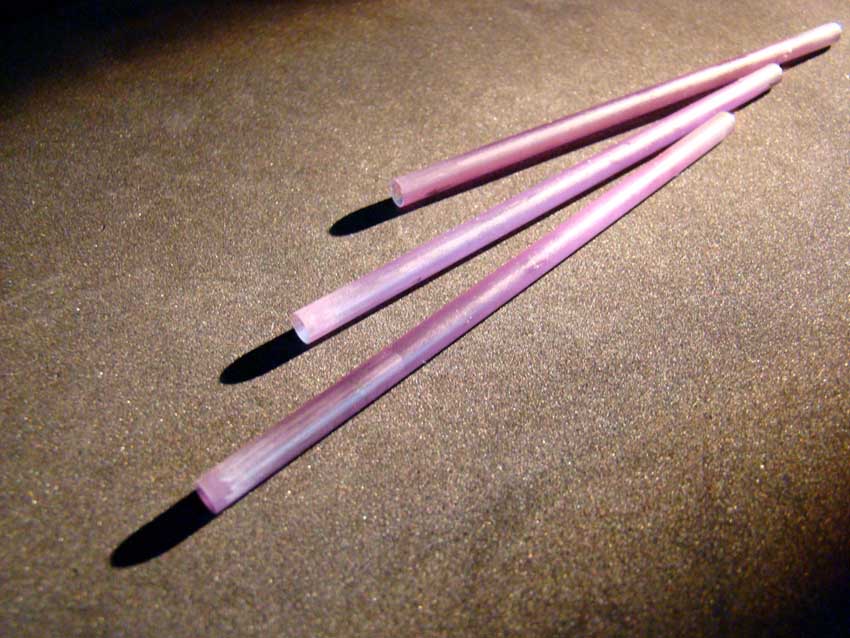
 Alexandrite laser belongs to the class of solid-state lasers. Impurities Cr +3 ions are 0.01–0.04% in BeAl 2 O 4 crystals
Alexandrite laser belongs to the class of solid-state lasers. Impurities Cr +3 ions are 0.01–0.04% in BeAl 2 O 4 crystals
The structure of the energy levels is similar to the structure of the energy levels of a ruby laser.
It was first used in 1973 with a wavelength of 680 nm. A little later, a method was invented how this laser can be tuned to other wavelengths (720-800 nm).
Alexandrite laser was the first laser on the market, which included re-wavelength adjustment.
The diagram on the left shows the principle of laser tuning.
Wavelength - 755 nm
Frequency - 3 Hz
Power - 125 W
Before using therapy, remove hair from the surface. The laser beam safely penetrates the skin, transforming into heat in melanin, heating the hair shaft. Heat destroys or weakens the follicle and the hair shaft loses its connection with the follicle. Hair falls out, and the absence of follicles means that the hair does not grow back.
So look nozzles for regulating the depth of penetration of the laser beam:

Nd: YAG is an aluminum-yttrium garnet (Y 3 Al 5 O 12 ) doped with neodymium ions (Nd).

 Neodymium lasers can operate in both continuous and pulsed mode. Pulse modes differ in the nature of the generation of laser radiation. In free generation, the pulse duration is usually equal to the lifetime of the upper laser level (about 250 µs, depending on the neodymium concentration), the pulse is a set of spikes with a duration of up to hundreds of nanoseconds. In the modulated Q mode, the duration can vary from nanoseconds to microseconds.
Neodymium lasers can operate in both continuous and pulsed mode. Pulse modes differ in the nature of the generation of laser radiation. In free generation, the pulse duration is usually equal to the lifetime of the upper laser level (about 250 µs, depending on the neodymium concentration), the pulse is a set of spikes with a duration of up to hundreds of nanoseconds. In the modulated Q mode, the duration can vary from nanoseconds to microseconds.
First demonstrated at Bell Labs in 1964. At present, they are used in such areas of medicine as ophthalmology, oncology, dermatology, dentistry and surgery.
Left - diagram of the energy levels of the neodymium laser)
Wavelength - 1054 nm
Power - 150 W
Before the procedure, the skin surface is cleaned from hair. The laser beam penetrates deep into the skin and heats the entire space. Heat destroys or weakens the follicle and the hair shaft loses touch with it. Hair falls out and no longer grows.

IPL is a technology used in medicine for various skin rejuvenation procedures. It is based on the generation of a light beam with different wavelengths (515 - 1200 nm) and the use of various light filters to influence certain tissues. The main difference from a laser is that IPL uses non-coherent and non-monochrome radiation.



Five replaceable light filters (spectral range of wavelengths: 500-950, 550-950, 650-950 nm)

The area of the working spot of the nozzle is 6.2 cm 2
The depth of penetration of the beam, depending on the filter:
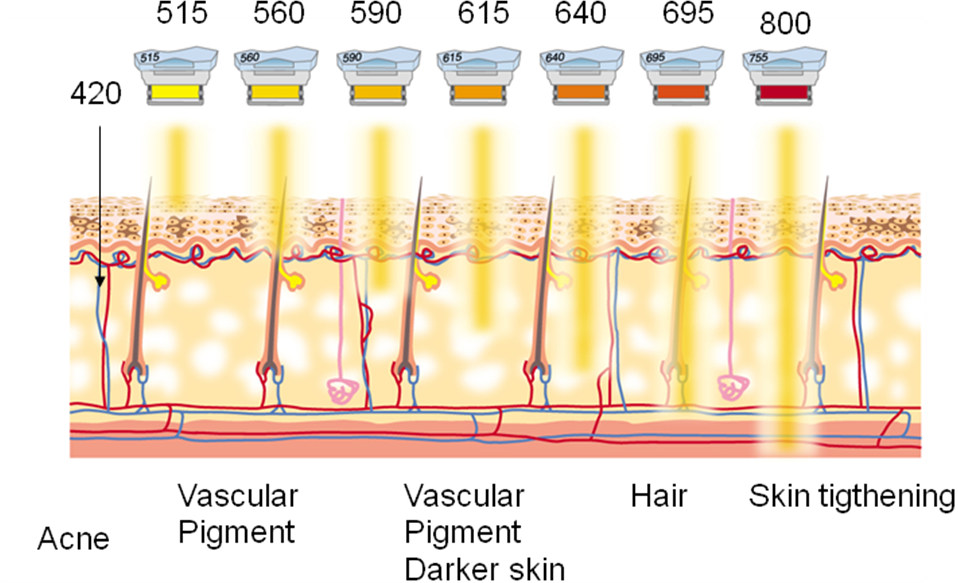
Beauty is a very interesting topic in which the physical aspect is only a part (depending on the source, from minor to dominant). There are interesting psychological phenomena associated with the perception of beauty: for example, among friends, a person is perceived as more beautiful. Another example relates to the fact that men are more willing to forgive beautiful women, and women are more willing to forgive less attractive women. People prefer to hire more attractive candidates.
- Dear, I went to the procedure, where I would have a solid-state yttrium aluminum laser doped with neodymium ions, diode-pumped, in Q-switched mode, with quasi-continuous coherent light will affect melanin in the anagen stage.
-
PS
UPD about terminology:
" Hello.
I read your article "Yttrium-Aluminium Laser with Neodymium Doping."
For some time I have been engaged in the synthesis, research and modification of compounds with the structure of garnet (http://bsu.by/ru/sm.aspx?guid=640593). The term doping is more applicable to metals. If we are talking about single crystals / glasses / ceramics, the profile literature usually uses the words activated or doped (sodoped, if there are several dopants).
"It is synthesized under laboratory conditions by the method of zone melting." The zone melting method is used either for the purification of single crystals or for their growth. Synthesis implies the process of formation of new compounds, cultivation - the restructuring of the structure without the formation of new compounds.
“Yttrium-aluminum laser with doping with neodymium” - a laser based on yttrium aluminum garnet activated (or doped) with neodymium ions (YAG: Nd). First, the main compound is indicated, and then the dopant.
"Solid aluminum yttrium". When n. YAG cannot be liquid, gaseous or plasma. He is always firm. Solid word here is an extra word. It would be more correct to write “a diode-pumped laser based on yttrium aluminum garnet activated with neodymium ions”. "

Jedi swords?
Personally, I am a supporter of natural ways to become more beautiful (sports, dancing, yoga, positive, normal nutrition, etc.), but at the same time I understand that there are cases when quick and effective intervention is necessary, so I decided to tell about the laser device which helps to make "all the rouge and nicer", like in a fairy tale. Or rather, about the principle of its work - I hope that after this publication the process of interaction between the laser and living tissue will become more understandable.
The introductory part presents some materials from the field of anatomy, without which it is not easy to understand the purpose of the laser. Also in the introductory question of protecting the eyes from laser radiation. In the second part, there is a description and principle of operation of the 3 systems that are present in the Synchro Play DEKA apparatus.
')

Content
Some theory
- Skin types
- Hair growth stages
- Types of lasers used in cosmetology
- Laser safety levels and goggles
- Mechanisms of laser effect on organic tissue
The principle of operation Synchro Play DEKA
- Alexandrite laser (BeAl 2 O 4 )
- Yttrium aluminum laser with neodymium doping (Nd: YAG, Y 3 Al 5 O 12 )
- IPL system (Intense pulsed light)
Some theory
Skin types
There are 5 types of skin that doctors share according to their optical characteristics. Depending on the skin type, the depth of penetration and the type of laser are selected.
About phototype differences
1. Celtic. Such people have tender, milky-white skin, often with freckles, red or very blond hair and blue or green eyes. The formation of pigment in the skin of such people is insignificant, they quickly burn and practically do not tan.
2. Nordic, Aryan. The skin of such people is light, freckles are little or not at all, light eyes, light, light blond, or brown hair. Sunburn goes bad, but a slight shade of the sun still remains.
3. Dark European. These people have brown or gray eyes, dark blond or brown hair. Slightly dark skin without freckles, sunbathes easily.
4. Mediterranean or South European. People of this type have dark olive skin without freckles, dark eyes and dark hair. People of this type tan well, almost without burning.
5. Indonesian or Mid-East. They have very dark skin without freckles, their hair is dark, their eyes are dark, their skin tans quickly without burning.
6. African American. They have very dark skin, black hair and eyes. Never burns. People with this skin type when carrying out cosmetology procedures need to be cautious and rely only on professionals, because during epilation such skin can give the effect of hyperpigmentation.
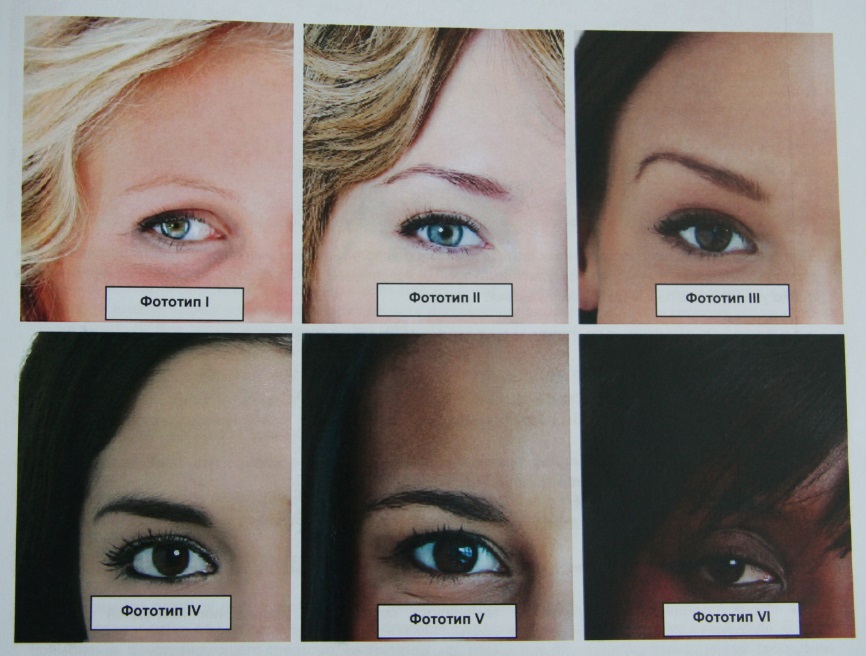
2. Nordic, Aryan. The skin of such people is light, freckles are little or not at all, light eyes, light, light blond, or brown hair. Sunburn goes bad, but a slight shade of the sun still remains.
3. Dark European. These people have brown or gray eyes, dark blond or brown hair. Slightly dark skin without freckles, sunbathes easily.
4. Mediterranean or South European. People of this type have dark olive skin without freckles, dark eyes and dark hair. People of this type tan well, almost without burning.
5. Indonesian or Mid-East. They have very dark skin without freckles, their hair is dark, their eyes are dark, their skin tans quickly without burning.
6. African American. They have very dark skin, black hair and eyes. Never burns. People with this skin type when carrying out cosmetology procedures need to be cautious and rely only on professionals, because during epilation such skin can give the effect of hyperpigmentation.

Hair growth stages
Human hair growth depends on many factors, such as age, sex, body weight, metabolism, hormones, ethnicity, medication and other factors. Whatever it was, hair growth takes place in three stages:
Anagen, catagen and telogen
1. Anagen - the period of active hair growth, its duration from 2 to 6 years. With age, the duration of the anagen phase decreases.
2. Catagen - a regression stage. Atrophy of the papilla occurs, as a result of which the cells of the hair follicle, deprived of nourishment, stop dividing and become keratinized. The duration of the catagenic stage is 1-3 weeks.
3. Telogen - the period of rest or rest of hair. Mechanical removal of hair in the telogen stage always entails the onset of the anagen stage, that is, the hair begins to grow again.
In healthy people, about 80-90% of hairs are usually in the anagen stage, 1-2% in the catagen stage, and 10-15% in the telogen stage.

2. Catagen - a regression stage. Atrophy of the papilla occurs, as a result of which the cells of the hair follicle, deprived of nourishment, stop dividing and become keratinized. The duration of the catagenic stage is 1-3 weeks.
3. Telogen - the period of rest or rest of hair. Mechanical removal of hair in the telogen stage always entails the onset of the anagen stage, that is, the hair begins to grow again.
In healthy people, about 80-90% of hairs are usually in the anagen stage, 1-2% in the catagen stage, and 10-15% in the telogen stage.

Types of lasers used in medicine
A lot of time has passed since the idea to direct a laser to a person for medical purposes (1960s), and this direction has yielded significant results and has been approved in the circles of doctors and cosmetologists. Commercial use of lasers in cosmetology dates back to the mid-90s, and this was preceded by 20 years of experimental research in this direction. The first article was published by a group of authors from Massachusetts General Hospital (conducting the world's largest research programs in the field of medicine) in 1998.
In cosmetology, the following types of lasers are most often used:

- Ruby laser: affects only light skin and dark hair, the absolute effect occurs after repeated use.
The first type of laser presented (1960), the wavelength is 694.3 nm, the pump source is a flash lamp. - Alexandrite laser: in comparison with ruby, it is distinguished by high speed and power, capable of removing hair on dark skin in the shortest possible time. Wavelength - adjustable in the range from 700 to 820 nm. The source of pumping is a flash lamp, laser diodes. For continuous mode - arc mercury lamp.
- Diode laser: has a deep penetrating ability, which allows to obtain much better results after epilation, but the hair removal procedure itself is carried out at a relatively low speed. Diode lasers are the most common in the world. The wavelength depends on the material and structure of the active region: from near UV to mid IR.
- Neodymium laser: acts even on relatively light hair and dark skin, penetrates deep into the skin. One of the most common high power lasers. Usually works in a pulse mode (fractions of nanoseconds). Often used in conjunction with frequency doubler. Known designs with quasi-continuous radiation mode. The wavelength is 1.064 microns. The source of pumping is a flash lamp, a laser diode

Laser safety levels and goggles
“Daddy, what will happen if I use a laser pointer in the eye of a lion when the trainer put his head in his mouth?”
A laser pointer (whose power is 1-20mW) is fun to play with a cat , but it is not recommended to shine in the eyes. Some hooligans blind pilots more powerful (500 mW) pointers. 1-10 W lasers burn a balloon or cap from a marker. What will be from a laser with a power of 125 or 150 watts?

Worldwide, the danger (or safety?) Of lasers is divided into several classes:
 Class 1. Lasers and laser systems of very low power, which are not capable of creating a radiation level dangerous for the human eye. Class 1 systems do not pose any danger even with long-term direct eye observation. In many countries, laser-powered devices with a higher power laser, which have reliable protection against the beam exiting the body, also belong to class 1.
Class 1. Lasers and laser systems of very low power, which are not capable of creating a radiation level dangerous for the human eye. Class 1 systems do not pose any danger even with long-term direct eye observation. In many countries, laser-powered devices with a higher power laser, which have reliable protection against the beam exiting the body, also belong to class 1.Class 2. Low-power visible lasers that can cause damage to the human eye if you specifically look directly at the laser for a long period of time. Such lasers should not be used at head level. Lasers with invisible radiation cannot be classified as Class 2 lasers. Usually, class 2 includes visible lasers up to 1 milliwatt.
Class 2a . Lasers and laser systems of class 2a, located and fixed in such a way that the beam into the human eye with proper operation is excluded. This class is used only in some countries.
Class 3a. Lasers and laser systems with visible radiation, which are usually not dangerous if you look at the laser with the naked eye only for a short period (usually due to the blink reflex of the eye). Lasers can be dangerous if viewed through optical instruments (binoculars, telescopes). Usually limited to a power of 5 milliwatts. In many countries, devices of higher classes in some cases require a special permit for operation, certification or licensing. International classes 2 and 3a roughly correspond to Russian class 2.
Class 3b. Lasers and laser systems that are dangerous when viewed directly on the laser. The same applies to the specular reflection of the laser beam. A laser belongs to class 3b if its power is more than 5 milliwatts. In Russia, roughly correspond to class 3.
Class 4. High-power lasers and laser systems that can cause severe damage to the human eye with short pulses (<0.25 s) of a direct laser beam, as well as specular or diffusely reflected light. Lasers and laser systems of this class can cause significant damage to human skin, as well as have a dangerous effect on highly flammable and combustible materials.
The device Synchro Play DEKA, about which today will be discussed, 4 class security, therefore, you need to be very careful.
Proof

The peculiarity of laser radiation is that it can get into the eye with closed eyelids, even because of the angle, and you may not notice it at all. Light to light is different, and below is the behavior of different wavelengths when it enters the eye.
Penetration of light with different wavelengths into the eye:

1. Ultraviolet light with a wavelength of less than 350 nm falling on the eye is absorbed by the cornea of the eye. The consequence of exposure to high power of light at these wavelengths is damage, leading to the destruction of the cornea or the formation of a cataract.
2. The light perceived by the retina is in the visible wavelength range (380 - 780 nm). Since human eye is sensitive to light, people have developed natural defense mechanisms. When the light seems too bright, i.e. power density exceeds the damage threshold of the eye, we automatically turn away and close our eyes (i.e. response or blinking reflex). This automatic response is effective for radiation power up to 1 mW. At higher powers, too much energy will be absorbed by the retina before we blink; this can lead to irreversible damage.
3. The near-infrared range (780 - 1400 nm) is the most dangerous for the human eye, because we do not have natural protection against it. The eye will feel radiation falling on the retina only after irreparable damage has already been done.
4. Infrared radiation in the range of 1400 - 11000 nm is absorbed by the surface of the eye and does not reach the retina. This leads to overheating of the tissue and burning, or destruction of the cornea. However, this occurs only at much higher power than those that are dangerous to the retina.
To the cosmetic procedure does not end at the oculist, use sunglasses 80 th level:

Laser flashes are so powerful that they even penetrate through the lowered eyelids. Therefore, special blind metal glasses are worn to the interest.

Points for the operator. For each type of lasers, glasses are selected with a specific light filter that transmits the maximum amount of visible light, but blocks light at the laser wavelength. Convenience of work in laser goggles depends on the parameter VLT (visible light transmission, visible light transmission).
The attenuation of light by a filter in the visible spectrum is determined by said VLT. It is determined by the ratio to the standard light source and is evaluated according to the spectral sensitivity of the eye to daylight. If the measured VLT value is less than 20%, then the user must ensure that there is additional lighting at the workplace. With low VLT and poor lighting, we can expect our eyes to adjust to what is called night vision. At the same time, color vision will be limited and the range of sensitivity of the eyes will shift towards shorter wavelengths.
Mechanisms of laser effect on organic tissue
 Laser hair removal is based on the principle of "selective photothermolysis" - selective absorption of light by various biological structures: hair pigment - melanin , which is concentrated in the stem and hair follicle, is able to absorb light waves of a certain length (optimal range 700-800 nm). As a result of the action of laser radiation, melanin, absorbing the energy of light, heats up and destroys the neighboring cells of the matrix (germ zone of the hair) and the vessels that feed the hair follicle. After a few weeks, the hair shaft with the dead “root” falls out.
Laser hair removal is based on the principle of "selective photothermolysis" - selective absorption of light by various biological structures: hair pigment - melanin , which is concentrated in the stem and hair follicle, is able to absorb light waves of a certain length (optimal range 700-800 nm). As a result of the action of laser radiation, melanin, absorbing the energy of light, heats up and destroys the neighboring cells of the matrix (germ zone of the hair) and the vessels that feed the hair follicle. After a few weeks, the hair shaft with the dead “root” falls out.Part of the hair follicles is in a sleeping state (about 10-15%) and 80-90% is in active growth. For maximum hair removal (90-100%), a series of hair removal procedures are needed with an interval of 20-45 days, depending on the individual hair growth rate. The number of procedures depends on the type and power of the laser system.
Skin type affects the absorption of waves of a certain length, so there are graphs and correspondence tables for skin phototype and laser / IPL type.

Read more about the effects on various tissues.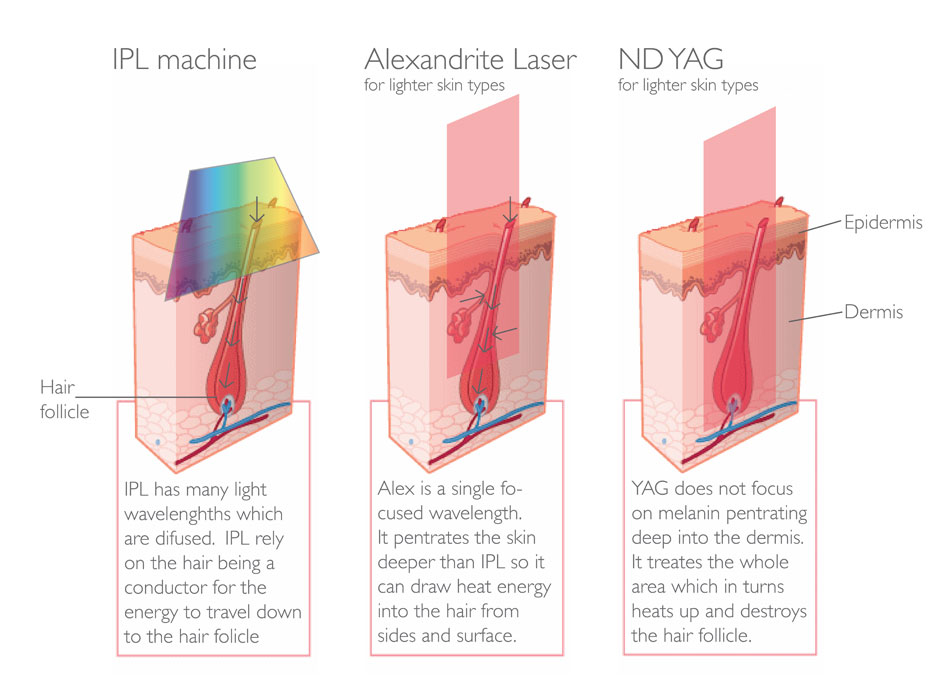
IPL emits waves of different lengths that are scattered. The tip of the hair is used as a conductor of heat to the hair follicles.
Alexandrite laser emits light of a certain wavelength. It penetrates deeper into the skin deeper than IPL and this allows the heat to be directed inside the hair from all sides and surfaces.
YAG laser does not focus on melanin. It affects the entire area, and thereby destroys the hair follicle.
Laser exposure to excessive pigmentation
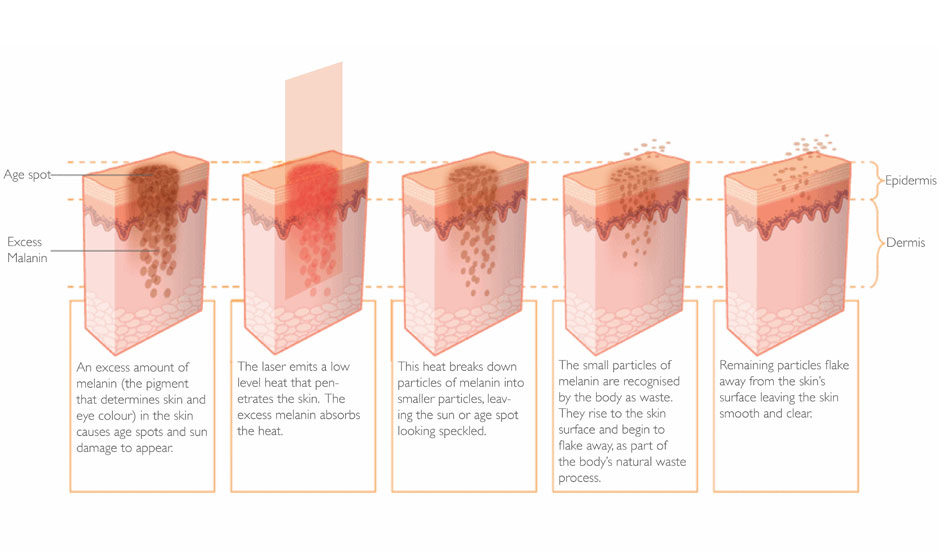
Excessive amounts of melanin lead to rapid sunburn and age spots. The laser emits a small amount of heat that penetrates the skin. Excess melanin absorbs heat and collapses, age spots thin out and become similar to a scattering of small specks. Small particles of melanin are recognized by the skin as unnecessary and come out with along with sweat. The remaining particles are separated from the skin, leaving it smooth and clean.
Laser effect on wrinkles
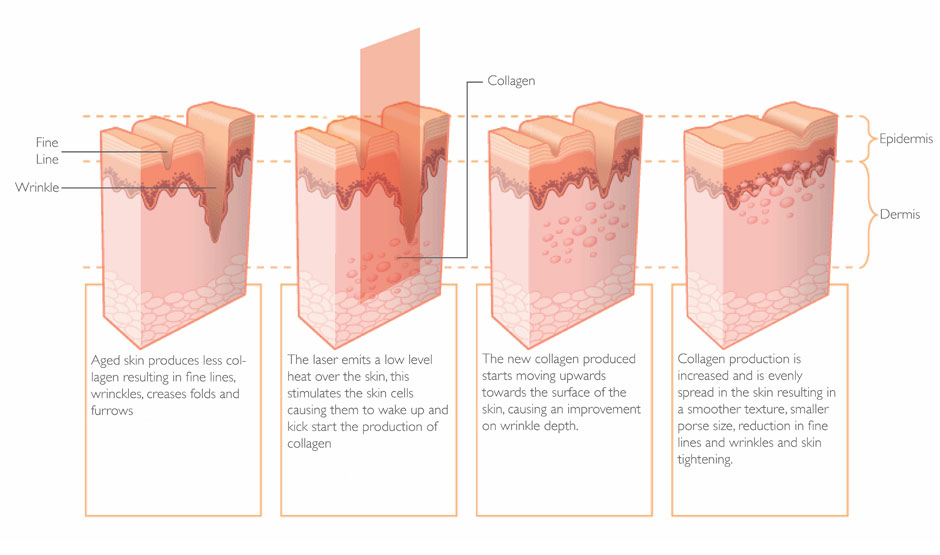
With age, the skin produces less collagen, resulting in wrinkles and folds. The laser radiates low power heat to the skin, stimulating the skin cells, respectively, they wake up and start the production of collagen. Newly produced collagen begins to move upward toward the surface of the skin, resulting in improvements. Collagen production is increased and evenly distributed over the skin, resulting in a smoother texture, smaller pore size, a reduction in the size of folds, wrinkles and skin seals.
Laser exposure to unwanted veins

Due to the incorrect functioning of the veins, some blood vessels become visible through the skin. The laser safely penetrates the skin and is absorbed by these vessels, destroying them and thus clearing the veins and healing them. The vessels that have been exposed first become blurred and can darken, and then are removed naturally and the skin becomes natural in color.

IPL emits waves of different lengths that are scattered. The tip of the hair is used as a conductor of heat to the hair follicles.
Alexandrite laser emits light of a certain wavelength. It penetrates deeper into the skin deeper than IPL and this allows the heat to be directed inside the hair from all sides and surfaces.
YAG laser does not focus on melanin. It affects the entire area, and thereby destroys the hair follicle.
Laser exposure to excessive pigmentation

Excessive amounts of melanin lead to rapid sunburn and age spots. The laser emits a small amount of heat that penetrates the skin. Excess melanin absorbs heat and collapses, age spots thin out and become similar to a scattering of small specks. Small particles of melanin are recognized by the skin as unnecessary and come out with along with sweat. The remaining particles are separated from the skin, leaving it smooth and clean.
Laser effect on wrinkles

With age, the skin produces less collagen, resulting in wrinkles and folds. The laser radiates low power heat to the skin, stimulating the skin cells, respectively, they wake up and start the production of collagen. Newly produced collagen begins to move upward toward the surface of the skin, resulting in improvements. Collagen production is increased and evenly distributed over the skin, resulting in a smoother texture, smaller pore size, a reduction in the size of folds, wrinkles and skin seals.
Laser exposure to unwanted veins

Due to the incorrect functioning of the veins, some blood vessels become visible through the skin. The laser safely penetrates the skin and is absorbed by these vessels, destroying them and thus clearing the veins and healing them. The vessels that have been exposed first become blurred and can darken, and then are removed naturally and the skin becomes natural in color.
Device Synchro Play DEKA
 My acquaintance with medical lasers began with this device. The product is Italian, combines three sources:
My acquaintance with medical lasers began with this device. The product is Italian, combines three sources:Alexandrite laser - 755 nm
Neodymium laser (Nd: YAG) - 1064 nm
IPL - Pulsed Light System
I will tell about them in a little more detail.
Alexandrite laser
Alexandrite is a natural stone, the most valuable chromium-containing chrysoberyl mineral (BeAl 2 O 4 ). The cost of natural alexandrite varies from $ 5,000 to $ 37,000 per carat. It is synthesized in the laboratory by the method of zone melting .

 Alexandrite laser belongs to the class of solid-state lasers. Impurities Cr +3 ions are 0.01–0.04% in BeAl 2 O 4 crystals
Alexandrite laser belongs to the class of solid-state lasers. Impurities Cr +3 ions are 0.01–0.04% in BeAl 2 O 4 crystalsThe structure of the energy levels is similar to the structure of the energy levels of a ruby laser.
It was first used in 1973 with a wavelength of 680 nm. A little later, a method was invented how this laser can be tuned to other wavelengths (720-800 nm).
Alexandrite laser was the first laser on the market, which included re-wavelength adjustment.
The diagram on the left shows the principle of laser tuning.
Wavelength - 755 nm
Frequency - 3 Hz
Power - 125 W
Principle of exposure to alexandrite laser
Before using therapy, remove hair from the surface. The laser beam safely penetrates the skin, transforming into heat in melanin, heating the hair shaft. Heat destroys or weakens the follicle and the hair shaft loses its connection with the follicle. Hair falls out, and the absence of follicles means that the hair does not grow back.
Visually

So look nozzles for regulating the depth of penetration of the laser beam:

Yttrium aluminum laser with neodymium doping (Nd: YAG, Y 3 Al 5 O 12 )
Nd: YAG is an aluminum-yttrium garnet (Y 3 Al 5 O 12 ) doped with neodymium ions (Nd).

 Neodymium lasers can operate in both continuous and pulsed mode. Pulse modes differ in the nature of the generation of laser radiation. In free generation, the pulse duration is usually equal to the lifetime of the upper laser level (about 250 µs, depending on the neodymium concentration), the pulse is a set of spikes with a duration of up to hundreds of nanoseconds. In the modulated Q mode, the duration can vary from nanoseconds to microseconds.
Neodymium lasers can operate in both continuous and pulsed mode. Pulse modes differ in the nature of the generation of laser radiation. In free generation, the pulse duration is usually equal to the lifetime of the upper laser level (about 250 µs, depending on the neodymium concentration), the pulse is a set of spikes with a duration of up to hundreds of nanoseconds. In the modulated Q mode, the duration can vary from nanoseconds to microseconds.First demonstrated at Bell Labs in 1964. At present, they are used in such areas of medicine as ophthalmology, oncology, dermatology, dentistry and surgery.
Left - diagram of the energy levels of the neodymium laser)
Wavelength - 1054 nm
Power - 150 W
Operating principle At the time of the flash of the pump lamp, the atoms of the active element go into the excited state and emit photons. Until the atom has moved from the excited state, a photon flying into it knocks out another photon, while the coherence, wavelength, polarization, phase of the photons of these photons will be exactly the same. Thus, the active element enhances the light, but this is not yet a laser, in order to produce a laser, generation is necessary.
At the time of the flash of the pump lamp, the atoms of the active element go into the excited state and emit photons. Until the atom has moved from the excited state, a photon flying into it knocks out another photon, while the coherence, wavelength, polarization, phase of the photons of these photons will be exactly the same. Thus, the active element enhances the light, but this is not yet a laser, in order to produce a laser, generation is necessary.
To run the generation, you must provide feedback. This is achieved by using mirrors. A deaf mirror returns more than 99% of the radiation, the output mirror returns about 90% of the radiation, while the output will be only 10% of the radiation, the efficiency is low. This is because if you return less radiation, there will be no generation. In any oscillator, which is actually an amplifier, where the signal from the output goes to the input, it is necessary that the gain factor exceeds the loss factor, otherwise there will be no generation. In the example: when the microphone is brought to the dynamics (for example, in karaoke) a strong “howl” appears, this means that feedback was provided in the system and the gain exceeded the loss.
 At the time of the flash of the pump lamp, the atoms of the active element go into the excited state and emit photons. Until the atom has moved from the excited state, a photon flying into it knocks out another photon, while the coherence, wavelength, polarization, phase of the photons of these photons will be exactly the same. Thus, the active element enhances the light, but this is not yet a laser, in order to produce a laser, generation is necessary.
At the time of the flash of the pump lamp, the atoms of the active element go into the excited state and emit photons. Until the atom has moved from the excited state, a photon flying into it knocks out another photon, while the coherence, wavelength, polarization, phase of the photons of these photons will be exactly the same. Thus, the active element enhances the light, but this is not yet a laser, in order to produce a laser, generation is necessary.To run the generation, you must provide feedback. This is achieved by using mirrors. A deaf mirror returns more than 99% of the radiation, the output mirror returns about 90% of the radiation, while the output will be only 10% of the radiation, the efficiency is low. This is because if you return less radiation, there will be no generation. In any oscillator, which is actually an amplifier, where the signal from the output goes to the input, it is necessary that the gain factor exceeds the loss factor, otherwise there will be no generation. In the example: when the microphone is brought to the dynamics (for example, in karaoke) a strong “howl” appears, this means that feedback was provided in the system and the gain exceeded the loss.
The principle of the impact of the neodymium laser
Before the procedure, the skin surface is cleaned from hair. The laser beam penetrates deep into the skin and heats the entire space. Heat destroys or weakens the follicle and the hair shaft loses touch with it. Hair falls out and no longer grows.
Visually

IPL - Intense pulsed light

IPL is a technology used in medicine for various skin rejuvenation procedures. It is based on the generation of a light beam with different wavelengths (515 - 1200 nm) and the use of various light filters to influence certain tissues. The main difference from a laser is that IPL uses non-coherent and non-monochrome radiation.



Five replaceable light filters (spectral range of wavelengths: 500-950, 550-950, 650-950 nm)

The area of the working spot of the nozzle is 6.2 cm 2
The depth of penetration of the beam, depending on the filter:

Conclusion
Beauty is a very interesting topic in which the physical aspect is only a part (depending on the source, from minor to dominant). There are interesting psychological phenomena associated with the perception of beauty: for example, among friends, a person is perceived as more beautiful. Another example relates to the fact that men are more willing to forgive beautiful women, and women are more willing to forgive less attractive women. People prefer to hire more attractive candidates.
- Dear, I went to the procedure, where I would have a solid-state yttrium aluminum laser doped with neodymium ions, diode-pumped, in Q-switched mode, with quasi-continuous coherent light will affect melanin in the anagen stage.
-

PS
UPD about terminology:
" Hello.
I read your article "Yttrium-Aluminium Laser with Neodymium Doping."
For some time I have been engaged in the synthesis, research and modification of compounds with the structure of garnet (http://bsu.by/ru/sm.aspx?guid=640593). The term doping is more applicable to metals. If we are talking about single crystals / glasses / ceramics, the profile literature usually uses the words activated or doped (sodoped, if there are several dopants).
"It is synthesized under laboratory conditions by the method of zone melting." The zone melting method is used either for the purification of single crystals or for their growth. Synthesis implies the process of formation of new compounds, cultivation - the restructuring of the structure without the formation of new compounds.
“Yttrium-aluminum laser with doping with neodymium” - a laser based on yttrium aluminum garnet activated (or doped) with neodymium ions (YAG: Nd). First, the main compound is indicated, and then the dopant.
"Solid aluminum yttrium". When n. YAG cannot be liquid, gaseous or plasma. He is always firm. Solid word here is an extra word. It would be more correct to write “a diode-pumped laser based on yttrium aluminum garnet activated with neodymium ions”. "
Source: https://habr.com/ru/post/234103/
All Articles